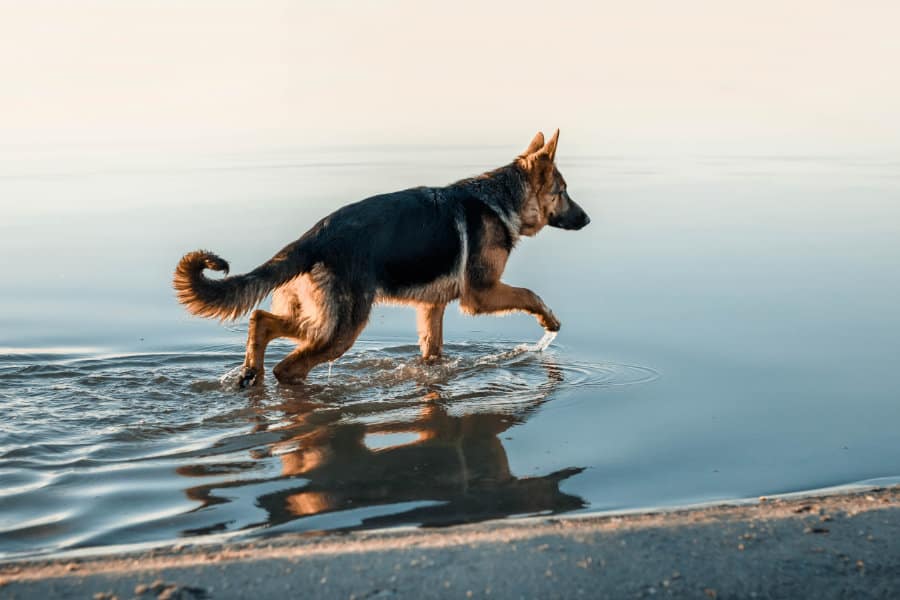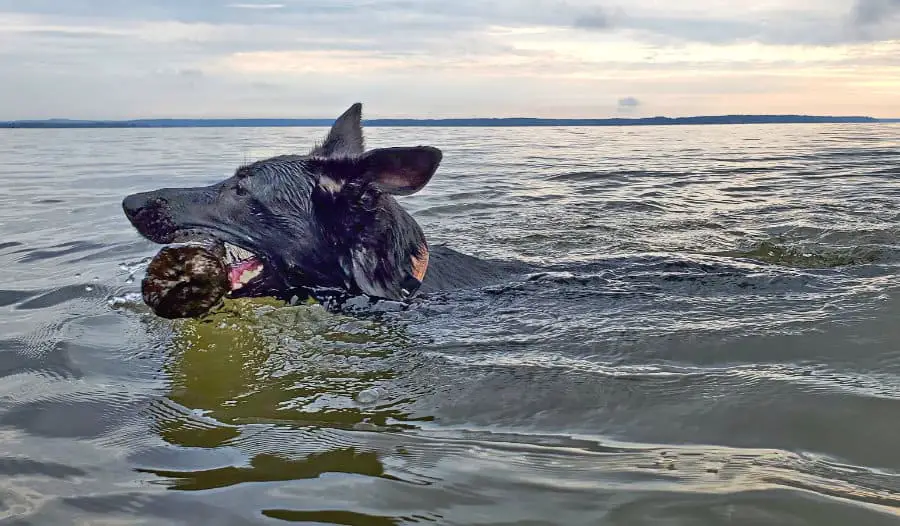German Shepherds are an incredibly active breed of dog. They can power through snow, have massive physical endurance, and can swim in water. While they are not bred to swim, they still have features that enable them to move through the water. With all the features that make a German Shepherd great, do they use their tails to swim, too?
Yes, German Shepherds do use their tails to swim. However, tail use is only a small part of helping them move through water. They also have intense, high-energy levels that give them endurance, along with other features such as…
- Long legs
- Webbed feet
- Long snouts
- Muscular build
- A Double coat
Although German Shepherds may use their tails to help with swimming, their tails are largely meant as a balancer and social signal. Keep reading to learn more about how German Shepherds use their tails for physical and emotional purposes.

Do Dogs Use Their Tails to Swim?
Have you ever wondered why dogs have tails? Dog tails have one major evolutionary purpose- to help with balance. As dogs tilt, they use their tails to help balance out their body weight to keep them from falling.
However, many dogs, including German Shepherds, use their tails as propellers to help them move forward through the water.
Do German Shepherds naturally know how to swim?
Most German Shepherds are natural swimmers. They have plenty of physical features that enable them to become water friendly.
Webbed Feet
German Shepherds, along with Labradors, Poodles, and many others, all have webbed feet. Similar to ducks, German Shepherd’s paws have a connective tissue that gives them extra help to swim.
Long Legs
The average adult German Shepherd stands at about 22 to 26 inches. Their tall legs give them an advantage over dogs with shorter legs, since each stroke is packed with enough power and length to propel them forward.
Long Snouts
There’s a good reason why the police force use German Shepherds. Their incredible snout allows them to detect bombs, narcotics, and missing persons. The large snout also gives them an advantage in the water, as they can breath longer and better as they paddle through the water.
Naturally Muscular
Swimming can be a straining activity for both people and dogs. Unlike walking or running, swimming requires a lot more strength and endurance.
Luckily for German Shepherds, they are naturally equipped with a thick muscular layer that allows them to propel themselves forward.
Do they like water? Water tolerance really depends on the individual dog. If your German Shepherd had a negative previous experience, is just a pup, or has an anxious personality, then don’t force your dog into the water.

Not Natural Swimmers
Although German Shepherds have many features that allow them to swim, that doesn’t mean that they evolved for water.
Other dogs like the Spanish Water Dog and the American Water Spaniel, however, were bred for water-friendly activities, whether that was hunting or helping humans get across rivers.
If you really want a swimming buddy, these breeds are a better alternative to German Shepherds:
- Barbet’s or “Mud Dogs”
- American Water Spaniel
- Chesapeake Bay Retriever
- Curly Coated Retriever
- Flat- Coated Retriever
What does it mean when a German Shepherd Wags Its Tail?
While a tail will certainly help your dog in the water, that is not the only reason why German Shepherds use their tails.
It’s important to pay attention to the way your dog wags its tail (or doesn’t wag it), as they indicate a confident, happy canine.
Excited and Happy
If your German Shepherd’s tail is moving at a rapid pace with wide swings, then this most likely means he or she is happy and excited.
Confident Alpha
When the dog’s tail is upright and straight, this usually means that your German Shepherd feels confident to take the lead with other dogs.
Relaxed
If the dog’s tail is down, but not completely ducked between its legs, then this is a sign of calm and relaxation
Embarrassed or Afraid
If your dog’s tail is tucked between its legs, it’s a sign of emotional distress, usually fear or embarrassment.
Aggressive
When the dog’s tail is extremely stiff and pacing rapidly back and forth, this usually means the German Shepherd has sensed a threat and is preparing to fight.
Why are German Shepherd’s tails always down?
Typically, with any breed, if the tail is down, it’s a sign of being submissive to their owner. Similar to tucking their tail between their legs when embarrassed, they will lower their tail when they know they’ve done something wrong and are waiting to see how their owner will react.
German Shepherd curled tail meaning
Many dogs have naturally curly tails, such as the Finnish Spitz Pomeranian, and some Huskies. German Shepherds, on the other hand, naturally have long and straight tails.
If your German Shepherd does have a curled tail, it’s nothing to worry about and is not a health concern.
Sometimes German Shepherds tails will curl up when they are trying to balance. Other times, they simply have a curly tail.
A curled tail on a German Shepherd is considered an untreatable genetic defect. While it is harmless, people are mainly concerned about their German Shepherd’s curled tail because of the aesthetics of their dogs appearance.
Depending on the purity of the breed, your German Shepherd will most likely have a tight curled tail when it’s born. This is perfectly natural and many German Shepherds tails straighten up after about a year.
Conclusion
While many German Shepherds share a long, straight tail, there is a chance of variation between breed types.
Keep in mind that the shape of the tail, and how it wags, is also determined by their emotional state.
While a German Shepherd uses its tail to swim, it’s not the most important anatomy part in keeping them afloat or propelling them forward. The tails acts as a secondary pusher through water, though they will mainly use their legs to maneuver themselves. More than anything, tails act as physical and social anchors, helping them maintain balance and determine social situations.
